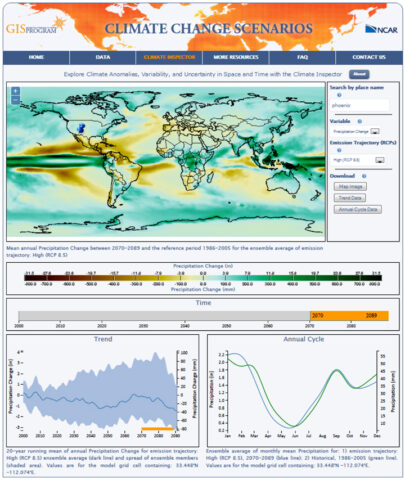As communities plan for and adapt to climate change, demand for usable climate information is growing. To do their jobs and protect their communities and themselves, policy makers, planners, businesses, and citizens need to know how factors like temperature and precipitation will change in the decades ahead.
For nonscientists to be able to use model results, the raw data must be translated into visually and conceptually comprehensible formats.
Climate models are designed to provide such information. However, for nonscientists to be able to use model results, the raw data that such models produce must be translated into visually and conceptually comprehensible formats.
A New Opportunity
In the past 2 decades, the increased accessibility of the Internet and advances in geospatial data portals have led to new, innovative ways to display, communicate, and distribute scientific information. With respect to climate model simulations in particular, geographic information systems (GIS) and advanced Web application technologies such as advanced browser-based user interfaces and data processing capabilities have proven essential for helping scientists and nonscientists examine changes in the climate and devise strategies for adaptation (e.g., planning for extreme heat events and droughts) and mitigation (e.g., reducing greenhouse gas emissions) [Sundaresan et al., 2014].
Although research and computational challenges still exist at the nexus of geographic information and climate sciences, a growing number of computer-based applications use spatially explicit information to help people working in climate change decision making and adaptation planning [Wilhelmi et al., 2015]. Examples of such applications can be found in the U.S. Climate Resilience Toolkit, a set of resources designed to help citizens, communities, businesses, resource managers, planners, and policy leaders manage their climate-related risks and opportunities and improve their resilience to extreme events.
One of the tools in the toolkit is the Climate Inspector, which provides a simple yet effective visualization of future climate simulations from the Community Climate System Model (CCSM), one of the leading global climate models.
Here we describe the application’s capabilities, available data, and underlying technology. We also discuss current and future work that the Geographic Information Systems (GIS) Program at the National Center for Atmospheric Research (NCAR) is doing to expand the Climate Inspector approach to providing usable climate information to researchers, educators, and the general public.
An Interactive View

The Climate Inspector is an interactive Web application that builds on GIS mapping and graphing capabilities to visualize projected temperature and precipitation changes throughout the 21st century (Figure 1). The application is a product of a nearly 10-year relationship between the NCAR GIS Program and the users of the NCAR GIS Climate Change Scenarios portal [Wilhelmi et al., 2015] (the Community Climate System Model [Gent et al., 2011] was used to derive data products).
Climate Inspector represents a new approach to exploring climate model outputs on the Web. This approach integrates spatial and temporal dimensions of climate modeling as well as the range of modeling experiments for multiple variables.
Our experiences distributing climate data to the GIS community, addressing frequently asked questions about climate model simulations, and responding to users’ requests for maps and graphs that convey complex scientific concepts in a usable way motivated us to develop the Climate Inspector. Since its release in 2014, the Climate Inspector has received more than 14,000 page visits, evidence of its popularity as a tool for communicating climate change information in a visually appealing and understandable way to the public.
Harnessing a Powerful Model
We generate the Climate Inspector’s maps and graphs from a large data set of climate simulations by the NCAR Community Climate System Model Version 4 (CCSM4) [Gent et al., 2011]. These simulations were prepared for the Coupled Model Intercomparison Project phase 5 [Taylor et al., 2012] and used in the Fifth Assessment Report of the Intergovernmental Panel on Climate Change [2014].
Data distributed through the Climate Inspector include simulations of 20th century climate and 21st century climate with four different representative concentration pathway scenarios, which represent possible future greenhouse gas concentration projections. With the Climate Inspector, users can explore how temperature and precipitation may change according to different representative concentration pathways (RPCs); investigate climate changes around the globe and through time; inspect climate trends, variability, and uncertainty; and download maps and data at approximately 1° spatial resolution. A place-name search allows users to select locations from a database of inhabited places across Earth.
Harnessing Technology
We used a number of technologies to build the Climate Inspector. All the CCSM4 climate simulations are stored as Network Common Data Form (NetCDF) data files. NetCDF is a platform-independent data format that supports the creation, access, and sharing of scientific data.
Data files are served by a Thematic Real-time Environmental Distributed Data Services (THREDDS) Data Server—a Web server that provides metadata and data access for scientific data sets, using a variety of remote data access protocols. The map in the Climate Inspector is generated through a Web Map Service request, and the data used in the creation of the interactive graphs are retrieved by an Open-source Project for a Network Data Access Protocol (OpeNDAP) request.
The Climate Inspector also uses Environmental Systems Research Institute (Esri) ArcGIS for Server technology for generating a base map showing state and country boundaries. The base map layer offers a number of scales, which are turned on and off depending on the zoom level. We used the OpenLayers 2 JavaScript library to build the map and the Data-Driven Documents library to generate the graphs.
The Climate Inspector is licensed under the Berkeley Software Distribution BSD 3-clause open-source license. The source code is available upon request from a private repository on GitHub.
Expanding Uses
Flexibility and extensibility are Climate Inspector’s key advantages as a platform for distributing and visualizing complex climate modeling data in a usable way.
Flexibility and extensibility are Climate Inspector’s key advantages as a platform for distributing and visualizing complex climate modeling data in a usable way. We have shown how the concept and the application of Climate Inspector can be expanded for sector-specific climate services.
An example of such extension is the Extreme Heat Climate Inspector. Extreme heat and climate change are growing public health concerns, and this application uses the mapping and graphing Web-based technology of Climate Inspector to provide data that officials will need in order to prepare for public health emergencies and mitigate urban heat. These data come from research on how occurrences of extreme heat events may vary as a result of climate change [Oleson et al., 2013].
For simulating future climate and extreme heat, Oleson et al. [2013] used NCAR’s Community Land Model coupled to an urban canopy model to quantify rural and urban summer heat stress over the United States and southern Canada at fine spatial resolution (0.125° in latitude and longitude) for the present day and for the middle of the 21st century, using one possible climate change scenario (i.e., RPC 8.5).
The Extreme Heat Climate Inspector allows users to explore projected changes in temperature as well as the five commonly used heat stress indices: the National Weather Service heat index, apparent temperature, simplified wet bulb globe temperature, humidex, and discomfort index. Through this interactive application, users can see the variations in high heat stress days and nights in cities and rural areas across the United States and can explore spatial patterns and seasonality of extreme heat across the United States, southern Canada, and northern Mexico.
Growing Urgency
As climate science and modeling evolve and the need for usable climate information becomes more urgent, the role of geospatial technologies, driven by the needs of users across research, education, government, and the private sector, will become more prominent. The new approach to exploring global climate change across space and time, as well as the two applications described here (Climate Inspector and Extreme Heat Climate Inspector), illustrates how we can integrate disciplinary knowledge from climate sciences, Web-based technologies, and GIS.
The concept of interactive data exploration, visualization, and distribution, developed through Climate Inspector applications, has great potential for delivering usable climate information to a broad range of users.
References
Gent, P. R., G. Danabasoglu, L. J. Donner, M. M. Holland, E. C. Hunke, S. R. Jayne, and M. Zhang (2011), The Community Climate System Model Version 4, J. Clim., 24(19), 4973–4991.
Intergovernmental Panel on Climate Change (2014), Climate Change 2014: Impacts, Adaptation, and Vulnerability. Part A: Global and Sectoral Aspects. Contribution of Working Group II to the Fifth Assessment Report of the Intergovernmental Panel on Climate Change, edited by C. B. Field et al., Cambridge Univ. Press, Cambridge, U.K.
Oleson, K. W., A. Monaghan, O. Wilhelmi, M. Barlage, N. Brunsell, J. Feddema, L. Hu, and D. F. Steinhoff (2013), Interactions between urbanization, heat stress, and climate change, Clim. Change, 129, 525–541.
Sundaresan, J., K. M. Santosh, A. Déri, R. Roggema, and R. Singh (2014), Geospatial Technologies and Climate Change, Springer, New York.
Taylor, K. E., R. J. Stouffer, and G. A. Meehl (2012), An overview of CMIP5 and the experiment design, Bull. Am. Meteorol. Soc., 93, 485–498.
Wilhelmi, O., K. Sampson, and J. Boehnert (2015), Exploring future climates in a GIS, in Mapping and Modeling Weather and Climate with GIS, edited by L. Armstrong et al., pp. 91–103, Esri, Redlands, Calif.
Author Information
Olga Wilhelmi, Jennifer Boehnert, and Kevin Sampson, National Center for Atmospheric Research, Boulder, Colo.; email: [email protected]
Citation: Wilhelmi, O., J. Boehnert, and K. Sampson (2016), Visualizing the climate’s future, Eos, 97, doi:10.1029/2016EO042207. Published on 7 January 2016.
Text © 2016. The authors. CC BY-NC 3.0
Except where otherwise noted, images are subject to copyright. Any reuse without express permission from the copyright owner is prohibited.

